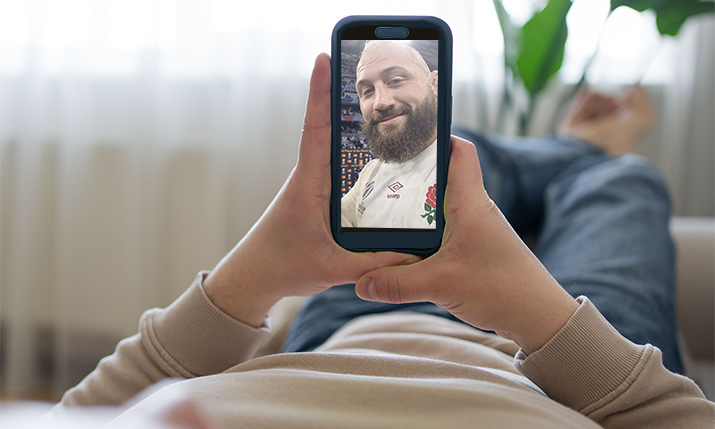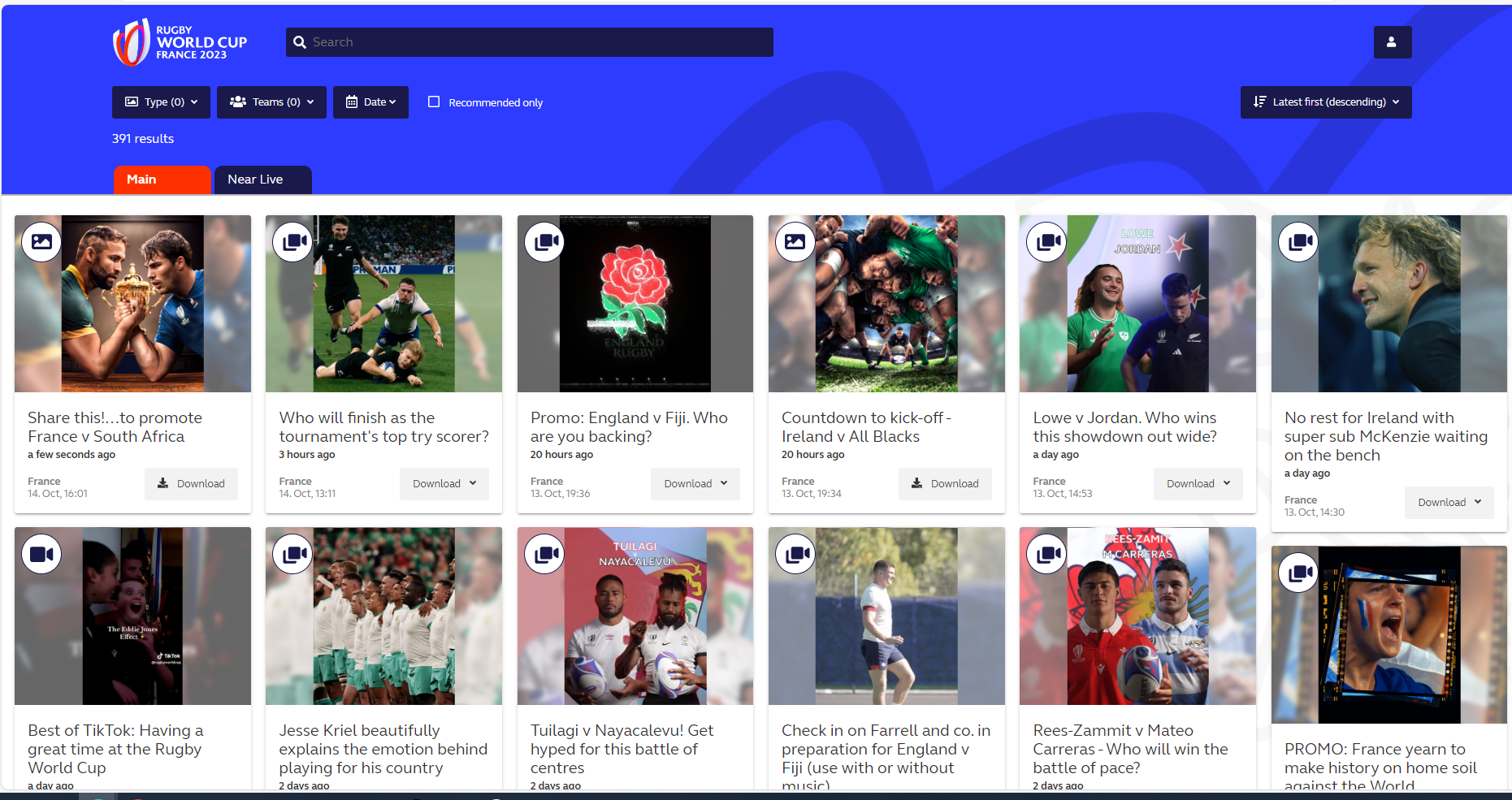Live from the Rugby World Cup 2023: Digital content production offering proves popular with broadcasters and ‘TikTok Generation’ alike

In an era where broadcasters are demanding more and more digital content for their social media channels, and viewers are more connected than ever, major sporting events are continuously evolving to keep fans engaged and informed. Rugby World Cup 2023 is no exception.
During SVG Europe’s visit to the IBC in Paris, we sat down to chat with Tim Stott, executive producer of digital at Host Broadcast Services (HBS), to discuss the digital content that is being produced for rights holders during France 2023.
One of the primary challenges faced by Stott’s team is creating content that resonates with audiences from diverse linguistic and cultural backgrounds. He explains, “This is an event-time digital production aimed at the rights holders who have chosen to take this package in different territories around the world. The challenge for us is we’ve got to make content which works in different languages and cultures.”
To address this, the team focuses on producing short-form mobile content tailored to the social media channels of the tournament’s broadcasters, with an emphasis on TikTok, but also Instagram and others.
“We want people to look at that angle and say, ‘that’s not something I get when I watch TV.’ Or for generation TikTok, ‘I don’t want the same angle that my Dad’s getting while he’s watching on TV.'”
He adds, “The benefit for broadcasters is letting fans who might have been asleep catch up. We need to cater for various time zones. And of course, promoting their upcoming matches. Showing the value of the game and saying ‘don’t miss it, it’s worth watching at this time of day.'”
At the same time, Stott emphasises that World Rugby, the federation responsible for the Rugby World Cup, has committed to mobile-first content, aligning perfectly with the nature of TikTok. “The raw, handheld, short, immediate, swipeable, behind-the-scenes vibes very much fit TikTok,” Stott notes.
His team captures candid moments that resemble a fan sneaking into the ground or onto the pitch with a phone, further enhancing the immediacy and authenticity of the content.
He cites an example (below) of England prop Joe Marler providing a “simply wonderful free grab at the start of the tournament, which got amazing traction.” This level of engagement exemplifies the power of mobile-first content in connecting with fans.
To streamline content delivery, Stott’s team has developed a bespoke app that facilitates the submission of 4:5 and 9:16 content directly in what is termed the Social Media Interface (SMI). This allows broadcasters to access raw, short videos and either use them ‘as is’ or adapt them for their own style or purpose. It also enables HBS to edit and refine the content, developing other types of content, such as complications, or styles that might suit different rights holders’ preferences or the platforms they use.
“We want to respect the choice of the customer [the rights holder] and how they use the content and how they fit that onto their platforms,” Stott emphasises.
Content produced for the Rugby World Cup 2023 varies widely, catering to a broad range of broadcaster preferences. Stott explains, “The higher-end promos have worked well, and likewise, the lower-end production stuff, like the videos from behind the try line, have also done great.” Broadcasters leverage these clips on their social media channels, creating a continuous stream of engaging content.
Moreover, the team recognises the significance of offering unique perspectives to the audience. Stott elaborates, “We want people to look at that angle and say, ‘that’s not something I get when I watch TV.’ Or for generation TikTok, ‘I don’t want the same angle that my Dad’s getting while he’s watching the match on TV.'”
“It’s an important skill, given the sensitivities of venues and the politics of standing on a particular blade of grass. We want people who’ve got their head screwed on, who know how to conduct themselves and have experience in pressure cooker environments.”
Approximately 25 individuals contribute to this project, combining expertise in rugby, social media, and content production. They are placed both at the venue and at Stockley Park in London. Stott notes the importance of having people in the team who understand the intricacies of working in high-pressure, live event environments.
“At the venue, it is a combination of people who already do rugby and who already do things like social media, and publishing from venues. It’s a very important skill, given the sensitivities of venues and the politics of standing on a particular blade of grass. We’re looking for people who’ve got their head screwed on, who know how to conduct themselves and have experience in that pressure cooker environment.
“In London, it’s more production skills. We’re doing illustrations, higher-end work, craft editing at a slightly more promo standard level, and then vertical editing, mobile-first, where we’re turning that phone experience into a very urgent and raw account of what’s happening in the matches.”
They make real-time editorial decisions about the type of content to produce. They ponder whether they should tell stories or share moments and they actively avoid producing content that can be easily found with a quick Google search.
“Not everything needs the same level of care and attention,” he adds. “Some content actually does better if you don’t mess around with it too much. While some require a lot more.”

The Social Media Interface (SMI) allows broadcasters to access raw, short videos and either use them ‘as is’ or adapt them for their own style or purpose
Given the nature of the content they produce, Stott’s team does not require broadcast-grade equipment. The team utilises off-the-shelf mobile phones with their app to gather material, ensuring a straightforward process that facilitates rapid content generation.
In a world where authenticity and immediacy reign, Stott emphasises that less is often more when it comes to creative treatment. They aim to avoid imposing a heavy stylistic stamp on content, allowing it to retain its raw, natural appeal.
“Some content is obviously far more optimised for TikTok than others. While a 4:5 ratio highly produced asset has got Instagram written all over it. But yet we don’t tell people how to use it.
Stott concludes by reflecting on the evolving landscape of digital content creation for major sporting events. He notes, “It’s amazing how it’s evolved, and the consumption of the content is much higher than it was back then. There’s an absolute expectation that there be content provided for filling social channels during a big sporting event. And we are happy to be there doing that.”
“It’s amazing how it’s evolved, and the consumption of the content is much higher than it was [in 2019]. There’s an absolute expectation that there be content provided for filling social channels during a big sporting event.”
Amanda Godson, World Rugby’s head of broadcast and production, is pleased with how the mobile-first content has been received. “The post-match celebrations are gold,” she says.
“Players are very keen to have a chat with a mobile phone and say ‘Hi’ to their fans back at home. What we’ve seen there is just brilliant and gorgeous, especially when you add in the little babies and children that are running around the pitch as well. It’s been very worthwhile and we’ve had very positive feedback from the rights holders.”
She also emphasises another benefit.
“The other thing with the social content is that you’ve only got a certain amount of space around the pitch, and we’ve already got our host broadcast cameras, the rights holder cameras, and the photographers that we need to take into consideration. So, by having a digital team that can capture additional content for all the rights holders, we reduce the number of people we need to have stationed around the pitch. That one person can get into the best position rather than having ten people wanting to all be there at the same time. It’s essentially a syndication of the host broadcast digital feed.”
The 2023 Rugby World Cup continues in France until Saturday 28 October.
Read more:
- Live from the Rugby World Cup 2023: World Rugby and HBS offer up additional content for rights-holding broadcasters
- Live from the Rugby World Cup 2023: Consistency and simplicity are key for host broadcast match coverage
- Live from the Rugby World Cup 2023: Referee mic plays crucial role in capturing atmosphere and ambience

